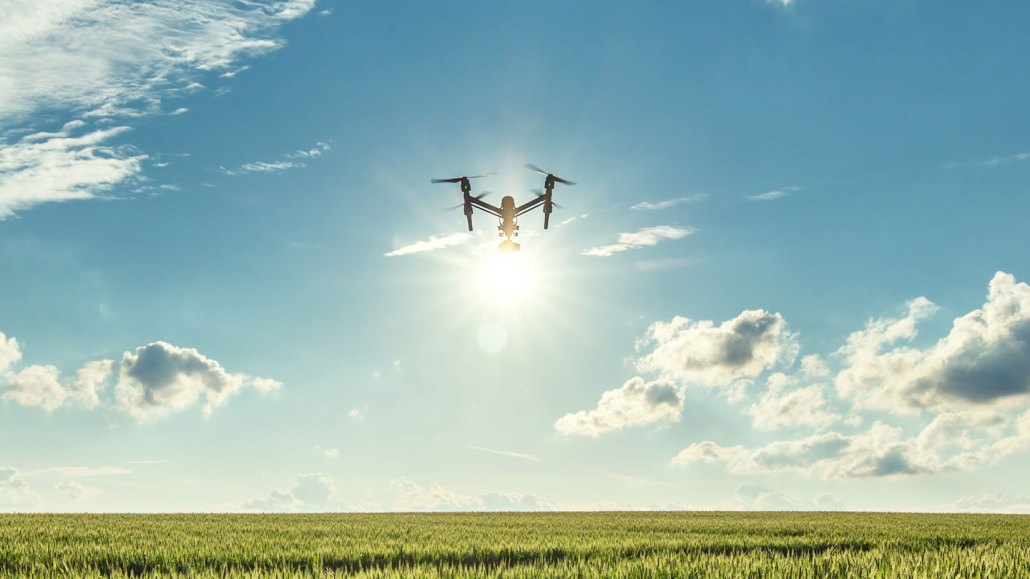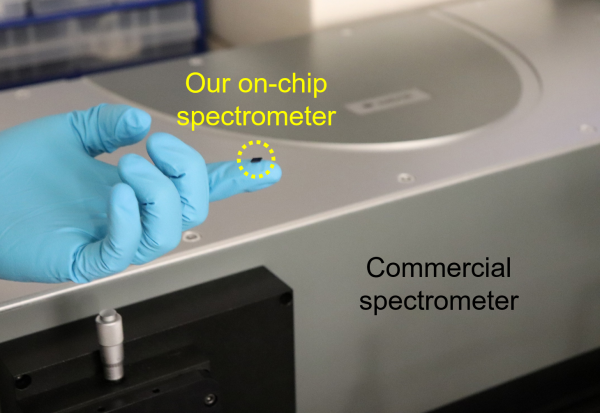A tool as small as a human cell can scan for contaminants and more
A mini version of a light-analyzing tool may enable more versatile, portable use

Tiny, portable spectrometers might someday fly on drones (like the one shown here) to monitor farm fields for pollutants or signs of crop disease.
valio84sl/iStock/Getty Images Plus
Share this:
- Share via email (Opens in new window) Email
- Click to share on Facebook (Opens in new window) Facebook
- Click to share on X (Opens in new window) X
- Click to share on Pinterest (Opens in new window) Pinterest
- Click to share on Reddit (Opens in new window) Reddit
- Share to Google Classroom (Opens in new window) Google Classroom
- Click to print (Opens in new window) Print
Does that food contain gluten? Could the fumes coming from that burning plastic be toxic? Did pollutants reach this farmland? Lab tools called optical spectrometers can identify chemicals to answer such questions. And thanks to a super-tiny new design, that superpower could someday be in your hands.
Most spectrometers sit on a tabletop. This new one is smaller than a human skin cell. Its size and performance make it ideal for use in small devices. Those might include a smartphone or drone, says Zhipei Sun. He’s a physicist at Aalto University in Espoo, Finland. Sun led an international team that described this new device October 21 in Science.
A spectrometer works a bit like a recipe in reverse. Recipes explain how to combine ingredients to make something. Spectrometers deconstruct what’s in something. They use light to identify its ingredients. The ingredients could be any type of substance — from single elements to complex molecules.
When light interacts with matter, each ingredient in that substance slightly changes the light. A spectrometer helps identify such changes by studying a broad range of colors (or wavelengths) of that light.
Desktop spectrometers send light through a sample or examine light coming directly from one. That light travels through a prism or grating at one end of the machine. This separates the light into its component colors — not just one hue, such as blue or red, but the specific shades that can be used to identify each ingredient. As the light continues to move through the device, these colors spread out and separate.
Sensors at the far of end of the machine capture the amount (or intensity) of each color, explains Hoon Hahn Yoon. He’s another physicist at Aalto University. He’s also a co-developer of the new device. The end result of this light analysis is a graph. It maps the light’s color versus intensity. Scientists call this a sample’s optical spectrum.
Each molecule or pure element will create a unique pattern of changes in that spectrum. Scientists have already identified these patterns for many known substances. To identify what’s in a new sample, a computer compares its optical spectrum to these known patterns.
The super tiny new device is the first to offer spectral analyses as detailed as the large spectrometers do, says Yoon. That’s important, he adds, because the more detailed a spectrum, the more accurate the list of ingredients it gives.

How they shrunk the device
Most spectrometers range from the size of a small refrigerator to a deck of cards, says Judith Dawes. She did not take part in the new work. But as a physicist at Macquarie University in Sydney, Australia, she works with optical tools. “As more and more of the technologies we use have been miniaturized,” she says, “we’ve realized it is possible to make spectrometers much smaller.”
Instead of prisms or gratings, the device by Sun’s team relies on two tiny flakes of semiconducting materials. One flake partly overlaps the other. Together, they sit on a computer chip. That chip is only the size of a rice grain.
Light shining on the flakes creates an electric current. That current’s strength is a measure of the intensity of the light. “This is the same basic technology that allows a photovoltaic solar cell to produce electricity from the sun,” Dawes explains.
To get a detailed spectrum, traditional spectrometers need lots of sensors. Each measures the intensity of just one color. The new device uses a single sensor to get data on all of the colors it measures, from visible light to the near-infrared. That data travels right from the chip to a computer. A computer program then uses artificial intelligence to match the resulting spectrum to known patterns in a database. Then it gives a readout of the chemicals to which it matched. Those chemicals are the ingredients of the sample.
Looking ahead
Sun and Yoon think it might take only a few years to make this tiny spectrometer available for use in phones and other products. “There is still room for engineering advances,” Sun says. However, he sees “no fundamental barriers to overcome.”
“What can we do with such a tiny spectrometer?” asks Dawes. Its size “makes it ideal for placing on a compact drone” or into a device that could be implanted in the body, she says. Small changes in the spectrum of the light its chip measures could signal changes in its environment. One day, she says, it may even be possible that “these devices could help blind people ‘see’ colors through lightweight spectacles.”
Adding a micro-spectrometer to smart devices, such as phones, could lead to other possibilities. People with food allergies could check their food for troublesome ingredients, says Sun. Or people at risk for lung cancer could monitor the gases they exhale for signs of the disease.
Such devices also could make it easier to monitor crop health, pollution, food quality — even the progression of some diseases, his team says.
“This is the beginning of the story,” Sun says. The real story will be all the discoveries and insights that these micro-devices provide.
This is one in a series presenting news on technology and innovation, made possible with generous support from the Lemelson Foundation.







